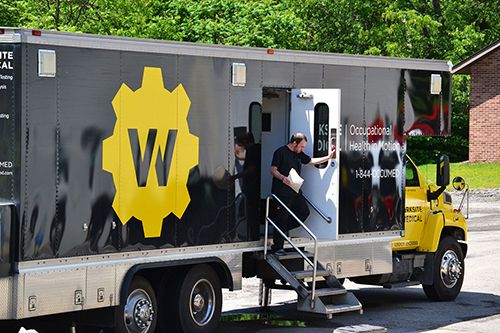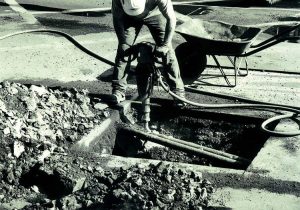Did you know an electric drill could be the difference between undue exposures to noise and silica dust, and the safety of your workforce?
Noise exposure is the amount of noise a person has been subjected to over a period of time. Noise is measured in decibels and stems from various sources. This can be from occupational areas stemming from factories, industries, machines, construction sites, etc.
Frequent exposure to loud noises kills nerve endings in the inner ear, limiting the ability to hear high-frequency sounds and understand speech. Over time, this damage can become permanent. Unfortunately, it can’t be cured with surgery or medicine. In order to prevent this from occurring, OSHA has a limit for noise exposure, set at 90 decibels (DBA) over an 8-hour work day.
When it comes to silica, statistics show that 2.3 million U.S. workers are exposed to silica in the workplace, including 2 million in construction and 300,000 in other industries.
Silica exposure is a silent threat that occurs when one inhales crystalline silica that is found in sand, rocks, etc. Silica particles are so small that they are easily inhaled and lodged in the lungs. Prolonged exposure can cause serious health problems such as silicosis, chronic obstructive pulmonary disease, lung cancer, and kidney damage.
Noise levels and silica exposure remain some of the many occupational hazards workers face, with employers responsible for keeping them safe.
Here, we’ll show you how you can protect your employees from these two dangerous hazards, and the benefits your business and workers stand to gain from taking appropriate precautions.
Related Article: Exploring 10 PPE Items for Your Hearing Conservation Program
Related Article: How to Protect Your Team from the Effects of Silica
Changing Your Drills May Reduce Hearing Loss
Each year, 22 million workers are exposed to potentially damaging noise on the job. Those who frequently drill concrete, such as construction or maintenance workers, are at the biggest risk of exposure to high levels of noise, dust, and vibration.
It’s estimated that $242 million is spent annually on workers’ compensation for hearing loss.
Related: Listen Up, Occupational Hearing Loss is Still a Problem
According to a major study, switching the drills in your workplace may help limit worker exposure to noise, dust, and vibration. This study, from the University of California, Berkeley, revealed that electric drills might be a much healthier and safer choice than pneumatic drills. Pneumatic drills are heavy pieces of equipment driven by compressed air. Electric drills are driven by an electric motor.
The study used a test bench robotic system to gauge and compare silica dust, handle vibration, and noise from both drills. The average level of noise for the electric drill was 102 decibels, compared to a higher 116.2 decibels for the pneumatic drill.
The pneumatic drill also maintained a vibration level five times higher than the electric drill.
Reducing Silica Exposure Due to Dust
While the sound difference was notable, the silica dust was perhaps the most significant difference between using either drill. The silica dust generated by the pneumatic rock drill was at least 444 times greater than OSHA’s PEL of 50 micrograms per cubic meter of air over an 8-hour time-weighted average.
The electric drill produced silica dust that was 11 times greater than the PEL.
The study also measured effectiveness and concluded that each drill was similarly effective.
In conjunction with proper hearing and respiratory protection, an electric drill can be a much safer choice for the workplace.
Medical Surveillance Testing For Noise and Silica Exposure
Medical surveillance testing for noise and silica exposure is essential in protecting workers’ health in high-risk environments.
Regular testing helps identify early signs of hearing loss and respiratory issues, allowing for timely intervention and treatment. Employers should implement routine screenings and provide protective measures, such as hearing conservation programs and respirators.
By prioritizing these health assessments, you can create safer workplaces and ensure that employees remain healthy and productive. Ultimately, proactive monitoring is key to preventing long-term health complications related to noise and silica exposure.
Benefits of Hearing Conservation
Hearing conservation programs are routine practices done to reduce the impact of loud noises on a worker’s hearing. Preventive in nature, the goal of these programs is to prevent noise-induced hearing loss through early detection.
Numerous benefits to a hearing conservation program exist, namely:
- Preserving hearing function
- Compliance with safety regulations
- Enhanced safety though better ability to hear warnings, sounds, and other important information
- Improved employee satisfaction
- Enhanced quality of life
- Improved communication on the worksite
- Reduced stress
Benefits of Respiration Protection
Respiratory protection is used in occupational areas to protect against respiratory disease. OSHA mandates the use of respiratory protection when work practices cannot adequately reduce silica exposure to permissible levels.
Respiratory protection is essentially about protecting your lungs and safeguarding your overall health.
Here are some key benefits:
- Prevention of respiratory diseases: protects against infections such as pneumonia, COPD and silicosis, all of which commonly occur when workers endure chronic silica exposure.
- Prevention against cancer: Silica contains carcinogens that can predispose one to lung cancer after constant exposure. The use of respiratory protection helps reduce silica exposure.
- Improved respiratory health: This helps to protect lung and overall respiratory health.
- Improved job satisfaction: Employees can work at ease knowing they’re well protected from harmful substances. This helps boost their morale and confidence in their employers.
- Compliance with regulations: Following OSHA guidelines keeps you free from any compliance problems, fines, and expensive citations.
Key Takeaways
Noise and silica exposure are major occupational health threats that can affect workers and reduce their quality of life. It is important that employers follow OSHA’s current limit for noise and silica exposure and ensure your workers’ safety.
It’s important to consider any changes you can make to reduce exposures to worksite hazards, whether it’s using electric drills, instituting a hearing conservation program, or any other number of options.
Each workplace must comply with OSHA standards and regulations and create a safe work environment.
Stay In Compliance With Worksite Medical
In most cases, OSHA requires medical surveillance testing, and at no cost to employees.
Worksite Medical makes that program easier with mobile medical testing.
We conduct on-site respirator fit tests, as well as audiometric exams, pulmonary function tests, heavy metal lab work, and much more – right on your job site. We also keep accurate, easy-to-access medical records for your convenience. You’ll keep your employees at work, and stay ahead of OSHA inspections.
All the protection you need, without the hassle of sending your team to an off-site clinic.
Protect your team and your workplace now with Worksite Medical. Not sure what you need? Try our medical testing wizard here.

Create a Less Disruptive, More Productive Occupational Health Plan with Worksite Medical!
Are you looking for a way to keep your team safe, while also limiting risk and increasing production? Simplify your medical plan today. We help team leaders like you develop less disruptive, more convenient occupational health plans that comply with complex industry standards, thus creating a healthier, more productive workforce. Take control of your medical testing program.




